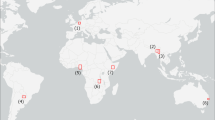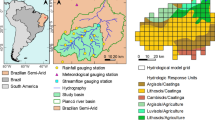Abstract
Parameter calibration is a core process for the application of distributed hydrological models, which depends strongly on river runoff records. However, the sparse distribution of hydrological gauging stations has largely limited the application of hydrological modeling. Remote sensing evapotranspiration (ET) data open a new avenue for the calibration of hydrological models. In this study, we used MOD16 ET, a data product from the moderate-resolution imaging spectroradiometer (MODIS), to calibrate a hydrological model in a two-phased approach. A simulated runoff time series was created with the Soil and Water Assessment Tool (SWAT) model that was automatically calibrated for ET in the first phase. The simulated runoff time series was then used in the second phase as the “observed” variable for a semiautomatic calibration in which runoff composition was further refined based on a comprehensive understanding of the local hydrological cycle. The results indicate that the output of simulated ET to MOD16 ET was acceptable and produced a reasonable runoff time series compared to the actual observed runoff, yet the composition of runoff was unsatisfactory for the different runoff components (e.g., surface runoff and base flow) after only automatic calibration. The runoff components were improved by semimanual calibration of the runoff sensitive parameters and resulted in a well calibrated distributed hydrological model. The increasing availability and improving quality of global ET datasets provide an alternative way to calibrate hydrological models, especially in ungauged meso- and large-scale basins. Even though the runoff gauging series is not a prerequisite for the method, some in situ observations are still valuable for the optimization of water cycle components.






Similar content being viewed by others
References
Abbaspour KC (2015) SWAT-calibration and uncertainty programs (CUP) - a user manual. Swiss Federal Institute of Aquatic Science and Technology. Eawag, Duebendorf
Arnold JG, Srinivasan R, Muttiah RS, Williams JR (1998) Large area hydrologic modeling and assessment - part 1: model development. J Am Water Resour As 34(1):73–89
Arnold JG, Gassman PW, Abbaspour KC, White MJ, Srinivasan R, Santhi C, Harmel RD, van Griensven A, van Liew MW, Kannan N, Jha MK (2012) SWAT: model use, calibration and validation. T Asabe 55(4):1491–1508
Batra N, Islam S, Venturini V, Bisht G, Jiang L (2006) Estimation and comparison of evapotranspiration from MODIS and AVHRR sensors for clear sky days over the southern Great Plains. Remote Sens Environ 103(1):1–15
Besaw LE, Rizzo DM, Bierman PR, Hackett WR (2010) Advances in ungauged streamflow prediction using artificial neural networks. J Hydrol 386(1–4):27–37
Beven K (2001) How far can we go in distributed hydrological modelling? Hydrol Earth Syst Sci 5(1):1–12
Bloschl G, Sivapalan M (1995) Scale issues in hydrological modeling-a review. Hydrol Process 9(3–4):251–290
Castiglioni S, Lombardi L, Toth E, Castellarin A, Montanari A (2010) Calibration of rainfall-runoff models in ungauged basins: a regional maximum likelihood approach. Adv Water Resour 33(10):1235–1242
Chau KW, Wu CL (2010) A hybrid model coupled with singular spectrum analysis for daily rainfall prediction. J Hydroinf 12(4):458–473
Dile TY, Ayana EK, Worqlul AW, Xie H, Srinivasan R, Lefore N, Yuo L, Clarke N (2020) Evaluating satellite-based evapotranspiration estimates for hydrological applications in data-scarce regions: a case in Ethiopia. Sci Total Environ 743:140702
Ehret U, Gupta HV, Sivapalan M, Weijs SV, Schymanski SJ, Bloschl G, Gelfan AN, Harman C, Kleidon A, Bogaard TA, Wang D, Wagener T, Scherer U, Zehe E, Bierkens MFP, Di Baldassarre G, Parajka J, van Beek LPH, van Griensven A, Westhoff MC, Winsemius HC (2014) Advancing catchment hydrology to deal with predictions under change. Hydrol Earth Syst Sci 18(2):649–671
El-Nasr AA, Arnold JG, Feyen J, Berlamont J (2005) Modelling the hydrology of a catchment using a distributed and a semi-distributed model. Hydrol Process 19(3):573–587
Gassman PW, Reyes MR, Green CH, Arnold JG (2007) The soil and water assessment tool: historical development, applications, and future research directions. Trans ASABE 50(4):1211–1250
Huang Q, Sun Z, Jiang J (2011) Analysis of impacts on the Lake water level of Dongting Lake by the operation of the three gorges reservoir. J Lake Sci 23:424–428
Immerzeel WW, Droogers P (2008) Calibration of a distributed hydrological model based on satellite evapotranspiration. J Hydrol 349(3–4):411–424
Jasechko S, Sharp ZD, Gibson JJ, Birks SJ, Yi Y, Fawcett PJ (2013) Terrestrial water fluxes dominated by transpiration. Nature 496(7445):347–350
Kunnath-Poovakka A, Ryu D, Renzullo LJ, George B (2016) The efficacy of calibrating hydrologic model using remotely sensed evapotranspiration and soil moisture for streamflow prediction. J Hydrol 535:509–524
Lawrence DM, Thornton PE, Oleson KW (2007) The partitioning of evapotranspiration into transpiration, soil evaporation, and canopy evaporation in a gcm: impacts on land–atmosphere interaction. J Hydrometeorol 8(4):862–880
Lombardi L, Toth E, Castellarin A, Montanari A, Brath A (2012) Calibration of a rainfall–runoff model at regional scale by optimising river discharge statistics: performance analysis for the average/low flow regime. Phys Chem Earth 42–44:77–84
Loukas A, Vasiliades L, Domenikiotis C, Dalezios NR (2005) Basin-wide actual evapotranspiration estimation using NOAA/AVHRR satellite data. Phys Chem Earth 30(1–3):69–79
McNamara JP, Tetzlaff D, Bishop K, Soulsby C, Seyfried M, Peters NE, Hooper R (2011) Storage as a metric of catchment comparison. Hydrol Process 25(21):3364–3371
Middelkoop H, Daamen K, Gellens D, Grabs W, Kwadijk JCJ, Lang H, Parmet B, Schadler B, Schulla J, Wilke K (2001) Impact of climate change on hydrological regimes and water resources management in the Rhine Basin. Climate Change 49:105–128
Moriasi DN, Arnold JG, Van Liew MW, Bingner RL, Harmel RD, Veith TL (2007) Model evaluation guidelines for systematic quantification of accuracy in watershed simulations. T ASABE 50(3):885–900
Mu Q, Zhao M, Running S (2011) Improvements to a MODIS global terrestrial evapotranspiration algorithm. Remote Sens Environ 115(8):1781–1800
Neitsch SL, Arnold JG, Kiniry JR, Williams JR (2011) Soil and water assessment tool theoretical documentation version 2009. Texas Water Resources Institute Technical Report, Texas
Odusanya AE, Mehdi B, Schürz C, Oke AO, Awokola ES, Awomeso JA, Adejuwon JO, Schulz K (2019) Multi-site calibration and validation of SWAT with satellite-based evapotranspiration in a data-sparse catchment in southwestern Nigeria. Hydrol Earth Syst Sci 23(2):1113–1144
Parajuli PB, Jayakody P, Ouyang Y (2017) Evaluation of using remote sensing evapotranspiration data in SWAT. Water Resour Manag 32(2):985–996
Phillips RW, Spence C, Pomeroy JW (2011) Connectivity and runoff dynamics in heterogeneous basins. Hydrol Process 25(19):3061–3075
Poméon T, Diekkrüger B, Springer A, Kusche J, Eicker A (2018) Multi-objective validation of SWAT for sparsely-gauged west African river basins - a remote sensing approach. Water 10(4):451
Saha S, Moorthi S, Pan HL, Wu X, Wang J, Nadiga S, Tripp P, Kistler R, Woollen J, Behringer D, Liu H, Stokes D, Grumbine R, Gayno G, Wang J, Hou YT, Chuang HY, Juang HMH, Sela J, Iredell M, Treadon R, Kleist D, Van Delst P, Keyser D, Derber J, Ek M, Meng J, Wei H, Yang R, Lord S, Van Den Dool H, Kumar A, Wang W, Long C, Chelliah M, Xue Y, Huang B, Schemm JK, Ebisuzaki W, Lin R, Xie P, Chen M, Zhou S, Higgins W, Zou CZ, Liu Q, Chen Y, Han Y, Cucurull L, Reynolds RW, Rutledge G, Goldberg M (2010) The NCEP climate forecast system reanalysis. B Am Meteorol Soc 91:1015–1057
Singh VP, Woolhiser DA (2002) Mathematical modeling of watershed hydrology. J Hydrol Eng 7:270–292
Sivapalan M, Takeuchi K, Franks SW, Gupta VK, Karambiri H, Lakshmi V, Liang X, McDonnell JJ, Mendiondo EM, O'Connell PE, Oki T, Pomeroy JW, Schertzer D, Uhlenbrook S, Zehe E (2003) IAHS decade on predictions in Ungauged basins (PUB), 2003-2012: shaping an exciting future for the hydrological sciences. Hydrolog Sci J 48(6):857–880
Sun Z, Lotz T, Chang N-B (2017) Assessing the long-term effects of land use changes on runoff patterns and food production in a large lake watershed with policy implications. J Environ Manag 204:92–101
Wang W, Chau K, Xu CX (2015) Improving forecasting accuracy of annual runoff time series using ARIMA based on EEMD decomposition. Water Resour Manag 29(8):2655–2675
Waseem M, Ajmal M, Kim TW (2015) Ensemble hydrological prediction of streamflow percentile at ungauged basins in Pakistan. J Hydrol 525:130–137
Zhang K, Kimball JS, Nemani RR, Running SW (2010) A continuous satellite-derived global record of land surface evapotranspiration from 1983 to 2006. Water Resour Res 46(9):109–118
Acknowledgements
This work was financially supported by the National Key Research and Development Program (2016YFA0602302, 2019YFA0607100), the Second Tibetan Plateau Scientific Expedition and Research Program (2019QZKK0202), the Natural Science Foundation of China (41671028), Strategic Priority of the Chinese Academy of Sciences (XDA23000000), Science and Technology Major Project of Inner Mongolia (ZDZX2018054), and the Sino-German Scientific Center (GZ1213). Constructive comments from anonymous reviewers are gratefully acknowledged.
Code Availability
Not applicable.
Author information
Authors and Affiliations
Contributions
All authors contributed to the study conception methodology, and original draft preparation. Data collection and analysis by Lotz Tom and Sun Zhandong. First draft manuscript by Sun Zhandong and Lotz Tom. All authors commented on previous versions. All authors read and approved final manuscript.
Corresponding author
Ethics declarations
Conflict of Interest
The authors declared that they have no conflicts of interest to this work.
Ethics Approval
Not applicable.
Consent to Participate
Not applicable.
Consent to Publish
Not applicable.
Additional information
Publisher’s Note
Springer Nature remains neutral with regard to jurisdictional claims in published maps and institutional affiliations.
Rights and permissions
About this article
Cite this article
Sun, Z., Lotz, T. & Huang, Q. An ET-Based Two-Phase Method for the Calibration and Application of Distributed Hydrological Models. Water Resour Manage 35, 1065–1077 (2021). https://doi.org/10.1007/s11269-021-02774-x
Received:
Accepted:
Published:
Issue Date:
DOI: https://doi.org/10.1007/s11269-021-02774-x




